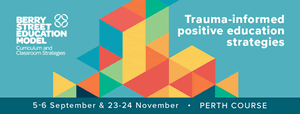Positive education must reach the students who need it the most. These students often struggle because their escalated stress response in a classroom environment makes it difficult to learn academic content; and important positive education strategies for resilience. They may have significant gaps in their academic achievement and often find it difficult to learn in a group setting. In addition to this, they may also have behavioural and social problems at school.
Three strategies that teachers can use to meet the needs of these students include:
- Understanding the impacts of trauma on the child, the family, and the intergenerational systems that surround the child
- Considering the effects of vicarious trauma, and
- Exercising a multidisciplinary approach to the role of the teacher in the trauma-informed classroom, and to their therapeutic relationship with the child.
In order to establish a school community where students received support that best meets their individual goals, several schools have used our Trauma-Informed Positive Education (TIPE) Model with successful results. The TIPE Model guides teaching and learning at these schools and encompasses a structured vision of wellbeing for the school community, including the special focus on our relational classroom environment and relationship based practice grounded in unconditional positive regard for the students. The relational context of the Trauma-Informed Positive Education (TIPE) Model concerns teachers working with students who struggle with emotional and behavioural dysregulation as a result of childhood trauma from abuse or neglect.
Within the University of Melbourne, the Youth Research Centre and the Centre for Positive Psychology have been our research and evaluation partners for the last four years. In their pilot evaluation, they found that schools which took on a trauma-informed positive education approach yielded two years of reading growth in just one year. We find this early data to be a clear and promising reason why educators must implement consistent strategies of trauma-informed wellbeing practice across the entire school. As a first step, we encourage teachers to have consistent strategies when managing a student’s resistance in the classroom by:
- Noticing the micro-moment of resistance (versus waiting for the student to escalate)
- Standing or kneeling shoulder to shoulder with student (versus standing over them and requesting their on-task behaviour)
- Offering a private choice to maintain and preserve the student’s self-concept (“Looks like you’re not sure where to begin. Do you want to start at the top of the page or the middle of the page?”)
- Grounding your student feedback in their character strengths (“You have the strength of fairness, and I’ve seen it so many times before. How can we use your strength to solve this issue together?”)
Teachers working within trauma-informed classrooms can draw on a variety of intervention models and practice frameworks. However, emergent themes are consistent within two broad categories of trauma-informed teaching: repairing regulatory abilities and addressing the dysregulated stress response, and repairing disordered attachment styles through forming strong teacher-student relationships. This healing approach is regarded critical. Trauma-affected students also need to be given opportunities in the classroom to increase psychological resources and build upon strengths that will sustain wellbeing – not just to reduce stress.




